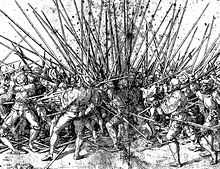Push of pike

The push of pike was a particular feature of late medieval and Early Modern warfare that occurred when two opposing columns of pikemen (often Swiss mercenaries or landsknechts) collided and became locked in position along a front of interleaved pikes. The push of pike would continue until one of the opposing formations collapsed, which would generally lead to massive casualties. During push of pike, opposing blocks of pikemen would advance with their pikes "charged" horizontally at shoulder level to jab at one another until bodily contact was made. The two sides would then push physically until one or other of them gave way. Each man pressing on the one in front, and so the action would have likely become a combination of hand to hand and push.[1][2] Rodeleros along with the doppelsöldner were used in order to break push of pike engagements. The push of pike played an important role in the English civil war as one-third of the infantry consisted of pikemen. Pikemen often cut down the lengths of their pikes in order to make them more manageable. This habit had on many occasions disastrous consequences as the side with the longest pikes had the advantage during push of pike.[3]
Battles involving push of pike
Anglo-Spanish War (1585–1604):
References
- ↑ "Gerards Pike". Retrieved 20 July 2014.
- ↑ "Dunbar". Retrieved 20 July 2014.
- ↑ "English Civil War". Retrieved 20 July 2014.
- Oman, Charles (1999). A History of the Art of War in the Sixteenth Century. ISBN 9781853673849.
External links
- "The ECW Pages - Infantry". Retrieved 3 December 2011.